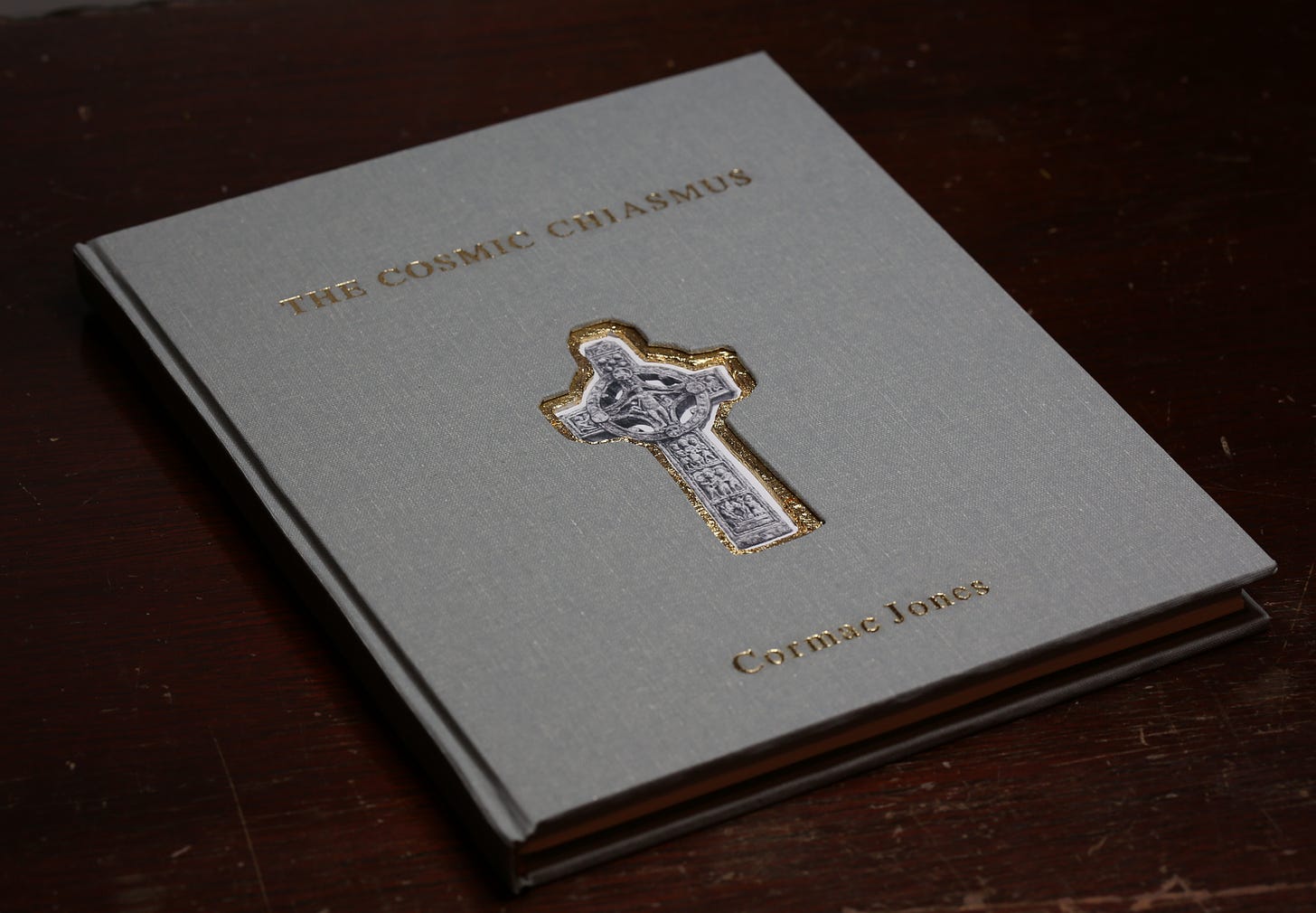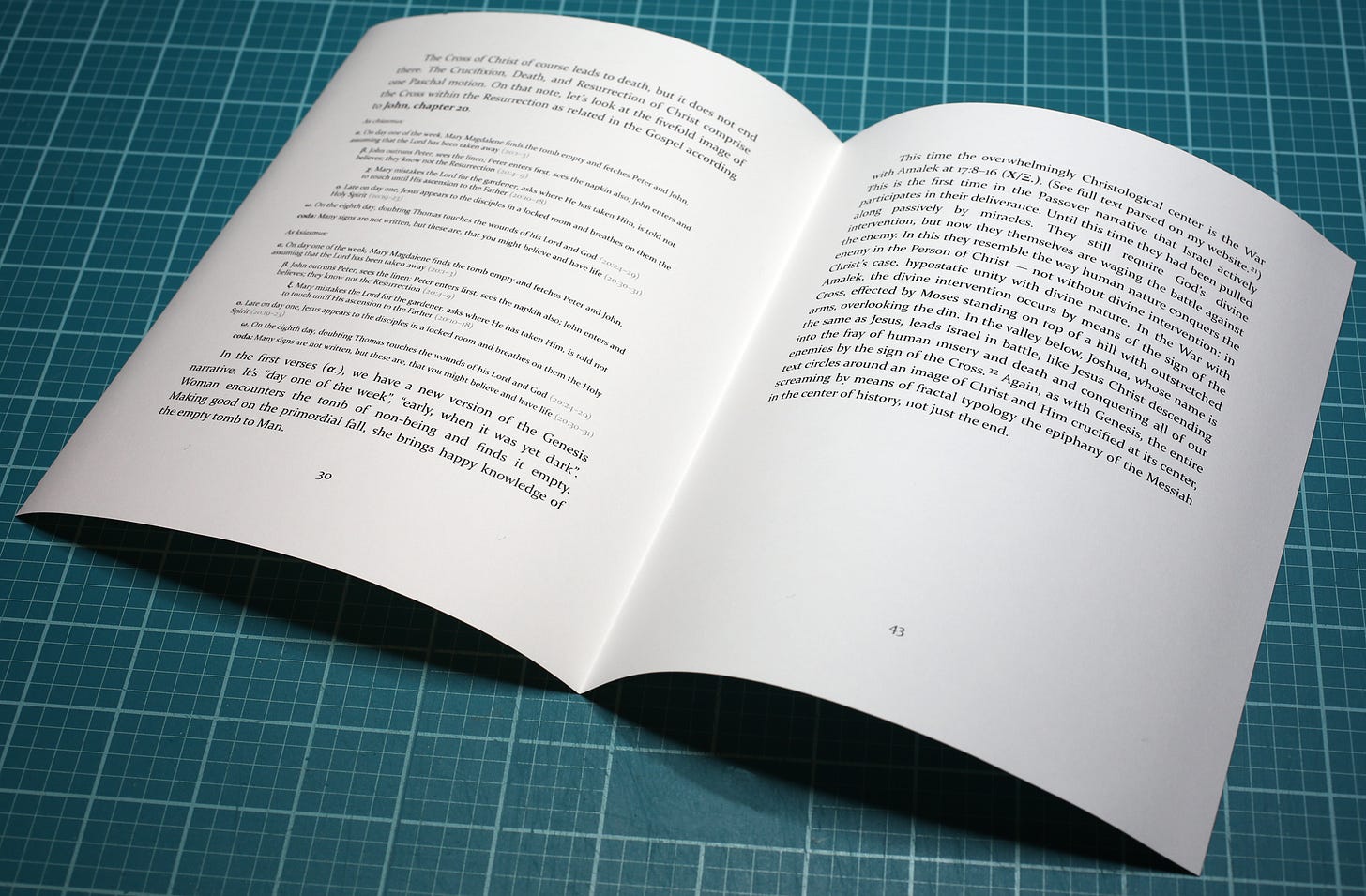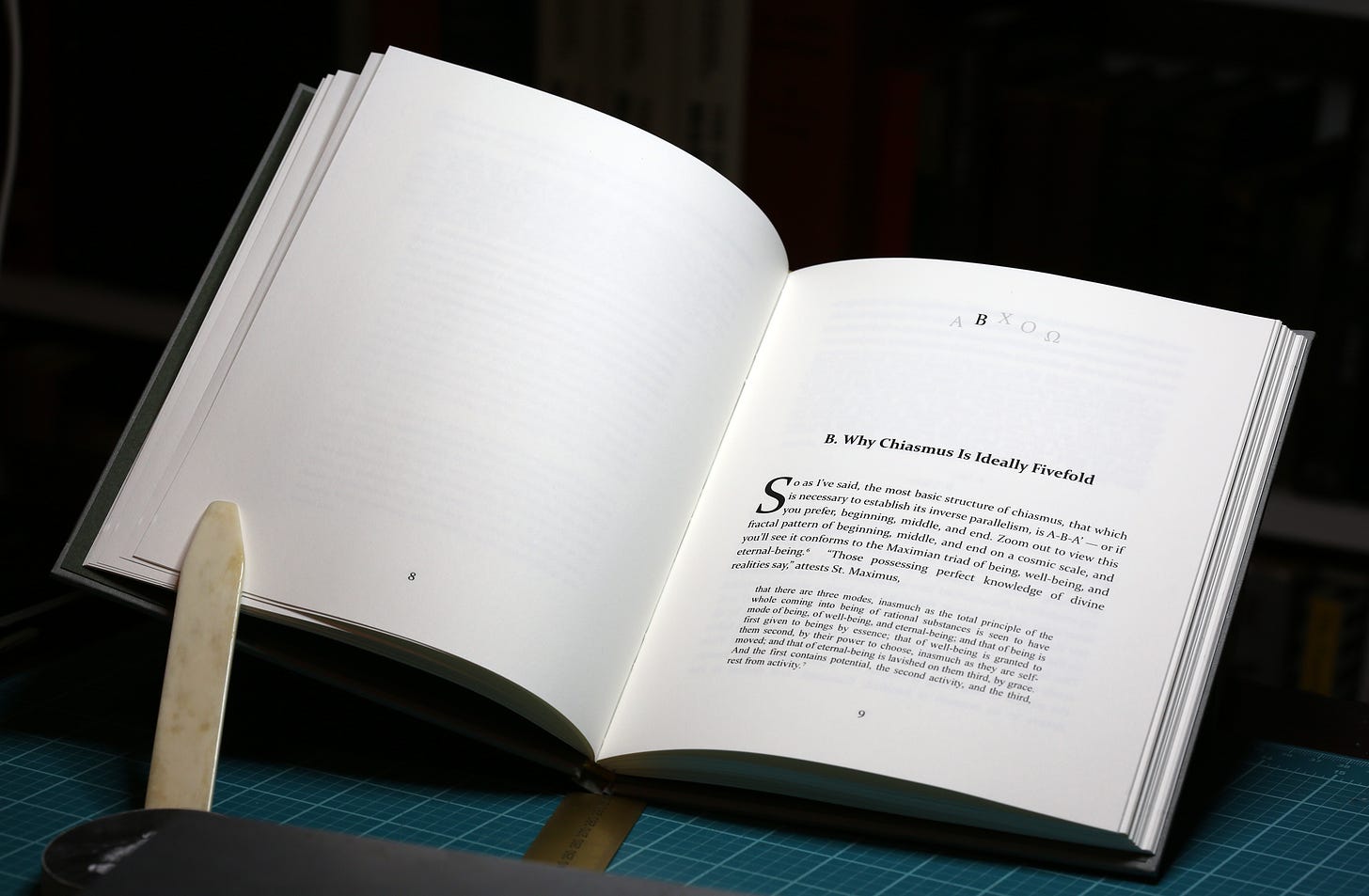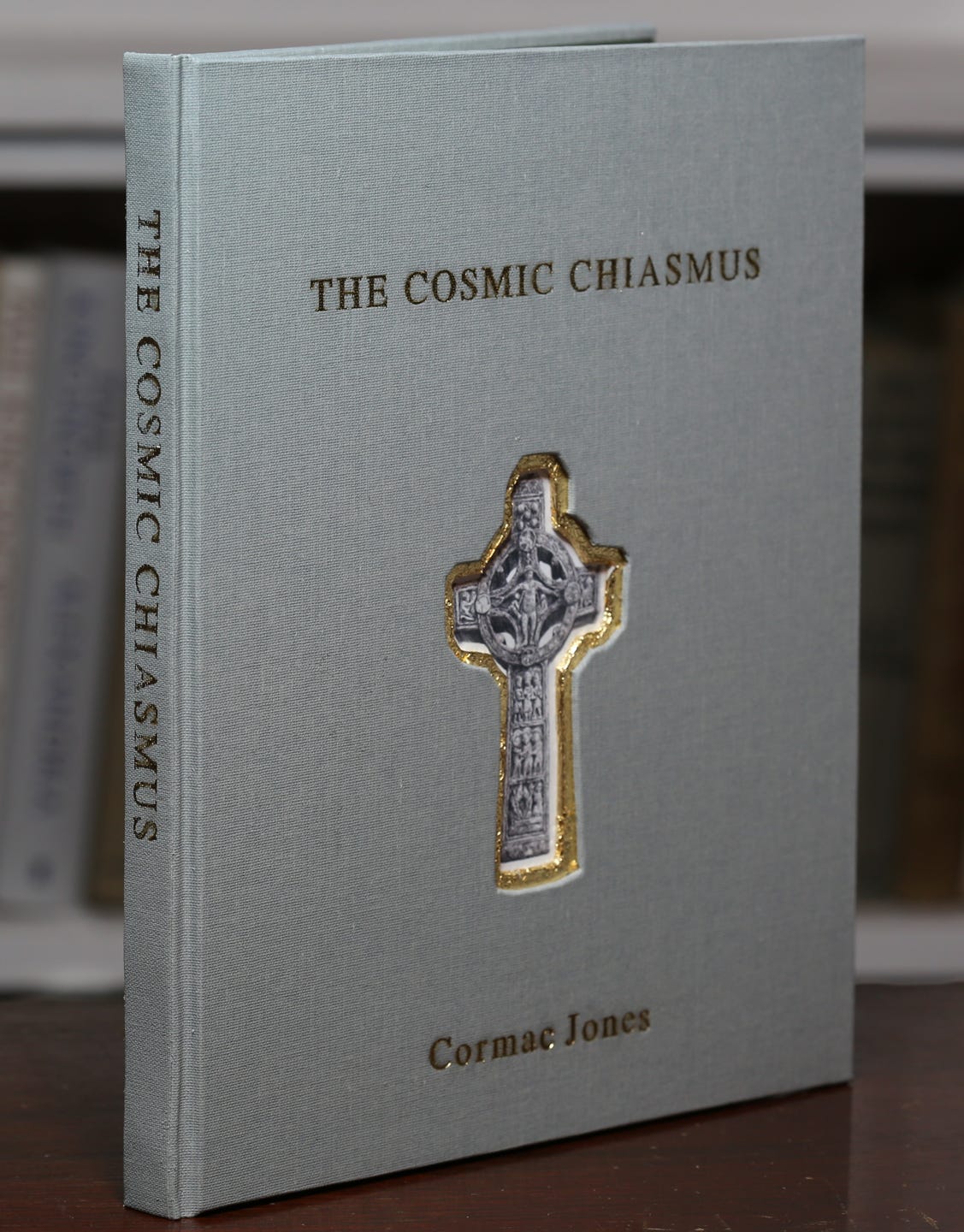Last November a very long article was published on Jonathan Pageau’s Symbolic World website written by its new editor, Cormac Jones, an excellent writer with great insight. The article shone light on a very important and fundamental pattern in the structure of the world that is also used by the writers of our Scripture.
“The Cosmic Chiasmus” does a wonderful job explaining how the structure of creation is revealed in the Scriptures. The patterns in the Biblical text lead us to see meaning on deeper levels than may be immediately apparent. Hopefully you have already read the whole of Cormac’s article. What I intend to do here is to explain how I designed and made a book that attempts to contain, present and manifest the meaning and spirit of this text. The book I made also brings the work down out of the ether, makes it less ephemeral and provides a greatly improved reading experience for eyes that are not as young as they once were.
If you have at least a basic understanding of the chiastic pattern, then you shouldn’t have too much trouble seeing that the crosses that illustrate this text manifest the pattern that I may first inadequately express as “four parts and a center.” Then I will try to patch up my weak description by saying that those four parts are made of two pairs. And further, that the members of those pairs are complementary, or roughly reflections of each other across a center in some way. If you wanted to make something, besides a cross, that gave abundant opportunities to illustrate chiastic structure, it would be difficult to find something better than a book.
To see how the material structure of a book echoes the chiastic pattern, it would be helpful to know something about how traditional books are constructed. Here is a very brief explanation of the most germane aspects. Watch for a bit of plant symbolism here because the word folio is etymologically related to leaf and perhaps even flower. From the Latin, a folio is a book made of sheets of paper. The sheet is folded down its center, into two leaves, and both of those leaves have a page on each side of them. This single piece of paper, once given a center, can now contain four pages of text.
The next step is to gather some leaves together into a stack that is often called a signature. A group of signatures is then sewn together through their centers to make the body of the book. In this case I used green Irish linen thread to join them. For this book I made five-leaf signatures. That’s five folds, ten leaves and twenty pages. The total number of pages I had to make was almost precisely right for five of these signatures evenly. As it worked out though, the last signature had a few more pages and required seven folds, but that didn’t bother me too much..
If your chiastic sense tingled a bit in those previous few paragraphs, you are probably getting a feel for the pattern.
The High Crosses of old Ireland are the central symbol to this work, in both on the cover of the book and in the illustrations accompanying the text. Centuries ago, the artisans who made these monuments well knew their craft and the rich symbolic language of their religion. Their minds were at least as sharp as their chisels as they carved their visions into stone. To reproduce one of these crosses for the cover I contacted David Flores, who does beautiful work and has good symbolic understanding. He did not disappoint, and he made a wonderfully detailed drawing of the ancient and weathered Clonmacnoise Cross of the Scriptures. This cross is revealed in the front cover from beneath two layers: the outer, covered in linen cloth (itself a great net of tiny crosses), under that, a layer of rough gold, then down to the center that is the cross — a chiasmus in cross-section. If you wanted to continue going deeper into the chiastic layers of the scripture presented in the carvings on the cross, you certainly could.
Beginning on the Table of Contents page, Cormac’s chiastic scheme of the text comes into view. At the top of the page, a little arc of markers is introduced as an aid to finding one’s place within the work, which will be seen at each chapter heading as one progresses through the book.
On the way up the chiastic arc, the chapters begin on the page in the reader’s right hand, on the way down, in his left. You may also notice the starting point of the text of the chapter head pages moving higher up the pages, rising like a swell as the central chapter approaches and then once again receding.
In the first chapter some vertical lines have been added to the scriptural diagrams, as sort of visual training wheels for readers new to seeing this type of pattern. If you find them distracting, please blame me. If you find them the least little bit helpful in seeing the structure more clearly for the first time, please thank Cormac for allowing them to be added.
The proportions of the book are a bit wider than usual. Trading away the Golden Ratio was worth it in this case. Cormac’s carefully made diagrams of Scripture passages needed space to open up. I deliberately allowed plenty of space on the page for the text to flow easily, like breathing. I emphasized the integrity of paragraphs and they were almost never broken across pages. Blank space on the page allows the reader to take in a portion of what he is reading without being pulled into the next page coming at him before he is ready. This pacing allows the reader to absorb and reflect, even if just for a moment, before starting the next page. It creates a place where the alignment between heaven and earth feels just a little more solid, something rare and precious in this life. I tried to carve out just a little piece of that for the reader here. I wanted the presentation of text on the page and the reading experience to feel like a natural cycle, like breathing. This desire came to me as I worked with the text, fitting it to the pages I was making. Each page has a completeness, even as it is also part of the flow of something greater.
The cycle of breathing itself can be thought of as a chiasm. Drawing the air into our center where it does its work, and then exhaling an air that has been changed in a way that other creatures can use. In the same way, we read from the pages, let the words do their work and then feel the thoughts condense or say a prayer. Two lungs, the heart, two nostrils. Two eyes, the heart, two lips. It is breathing, not a mere inflation, a puffing up, but a cycle with a completeness in itself, yet also part of something greater, a rise and fall of the chest within a lifetime of breathing.
There now exist twelve of these books. I made twelve of them to test myself. The number twelve seems to carry along with itself a sort of implied completeness, months, hours, dozens... I knew I could make one, but could I make twelve? Yes I could. If you can do something a dozen times, usually you can say that you have a pretty good grasp of it, at least for a time. It is a discipline. In life you may do things over and over, aiming for a perfectly perfect cycle, never quite achieving it, but hopefully you end up with a collection of smaller and smaller imperfections each time around, theoretically at least.
Going further, I thought it was time to send the projects I have been making out into the world. The number twelve appeared again here. In the New Testament of the Bible there were twelve men who had their ordinary lives before they met Christ. Going through the Cross, it was Christ, who became a man so that man may become God, who crossed the center, and those twelve men on the other side of that transformative encounter carried Christ and His Church out into the world. All of history turned on that Cross in the center. That seemed like a good pattern to carry on, so twelve it was.
If it seems as if I have handled this book as something a bit too holy, this book that contains the word “super-fun” and “Go home, English, you’re drunk,” your criticism is heard and allow me to explain. Cormac is a super-good writer with great insights, but what gives this book its real strength is his invocation of this symbol of the Cross and the pattern that forms in the wake formed around it in reality. It is a beautiful attempt to help readers understand the ultimate symbol, the symbol of symbols, that stands at the center of the cosmos. The chiastic structures that he describes are more than just poetic or rhetorical devices. They are descriptions of and manifestations of a pattern that ripples through the forms we see in the world and can’t be unseen. Pointing it out helps tune us in. It helps us understand how things connect to one another, how they move together, how they flow. And when I use the word things, I’m not being vague, I mean this pattern billows through the fabric of everything.
The Cross is what gives this pattern its shape and this work its power and makes it to shine light all around it. This is why the Cross is lifted up and carried through time, or rather time is carried around it. This is why I decided to make this book, to carry some of this light a little further out into the world. This is the symbolism of the book I made.




















Also, I approve of all the green here. Very nice. (Never change it, or this comment won't make sense anymore!)
A lovely demonstration of what you've achieved with this project, Colin. I am so honored to have worked with you on it — and to have my own copy! You've altered my thinking on the possibility and appeal of publishing chiastic studies in book form. Thank you so much!